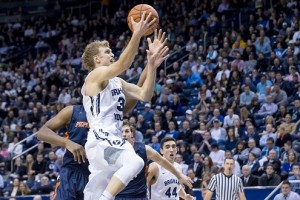NCAAB Bracket Pool: Strategies and Tips

I have been playing Bracket Pools since 2003 and have been relatively successful in 50-250 person pools with the same strategies. You are not going to win every year. There is just too much variance. But a set group of strategies can help you reduce this variance and at least come in the top percentage of your pools every year.
Here’s a look at some things you need to consider when filling out your brackets.
Scoring
There are two main scoring systems. The first is the traditional scoring system, which gives you one point for the first round and doubles after that, making each round worth 32 points. This scoring is VERY highly weighted on picking the champion, and if you do not have the champion, especially if it is a popular pick, there is little chance of winning. The other scoring system which has become more popular lately is the Fibonacci method, named after the famous mathematician. I will not get into his life which can be Wikipedia’ed, but the scoring is this: 2, 3, 5, 8, 13, 21. It puts a higher value on early games while still maintaining the importance of picking the champion. Of course, there are some other methods, like the upset method where you get bonus points for upsets and some other ones which I will not get into.
Champion
First, I begin by attempting to pick a champion. This year, the overwhelming favorite is Kentucky, so one may think that the easy choice is to pick Kentucky as your champion, which certainly would not be a bad decision. I like to maximize my winning percentage though, and with a large pool > 50 entries or so at times it pays to be contrarian, just like in GPPs in DFS. Right now Vegas has Kentucky at almost an even money favorite to win the title, and some of the advanced metrics have them anywhere from between 30% to 50%. That correlates with around 70% of brackets with Kentucky as the champion.

While I would never advise dropping Kentucky from the bracket early, I do believe that having them lose in the Final Four or the Championship game is a shrewd play, as it will differentiate you from the 70% who do have them winning. That being said, if I have multiple brackets in a pool, I am definitely going to have Kentucky as the champion and will not be dropping them until the Final Four, as nearly everyone will have them at least to the Elite Eight, so a loss early won’t lose any points.
Who Else?
So, if we’re not picking Kentucky as champion, who should we pick? Most champions come from a top 20 efficiency rating in both offense and defense. Of course Kentucky is at the top in those categories, but other contestants we have in that category are Arizona (11th and 3rd), Villanova (4th and 13th), Utah (18th and 8th) and Gonzaga (6th and 20th). Close but not making the cut are Wisconsin (1st and 30th) and Virginia (27th and 1st). Not picking a team who has the top offense or the top defense because their other metric is shaky is splitting hairs, and both Wisconsin and Virginia have solid shots at winning the title game. I will eliminate two teams here, as Virginia has a giant question mark with Justin Anderson’s pinky and the fact that they did not win their conference title game. There are too many questions with this team and they really struggle to score without Anderson, so they are not a champion for me. Utah also did not win their conference championship and looked like their confidence was shaken down the line. If you really like their efficiency numbers, they make an extremely contrarian pick for the champion, however I cannot do it. That leaves me with five potential champions in Kentucky, Arizona, Villanova, Gonzaga and Wisconsin. Those are the teams that I will be spreading around in my brackets as champs.
Final Four
Next we need to pick the final four. Of course, if a team profiles as a champion, it has a good shot at making the Final Four as well, and all of those teams above are in play and will be heavily used in my brackets. Generally, I do not go too much off the chalk in the final four picks, as picking 3 of 4 final four teams is likely to win you your pool (depending on how chalky this tournament is, with Kentucky this year you may need 4 of 4). Teams like George Mason, Butler and VCU are great stories, but picking teams like that to make the Final Four is a fool’s errand. Instead, look at teams who are high on the efficiency ratings and may have an easier time getting through. If I am picking a lower seeded team for the Final Four, I will need to be incredibly confident in my opinion of getting them through the first round. Nothing kills you more than losing your final four pick in the first weekend.
Who to Avoid
Next is the part where you fill out the rest of the bracket. With the Fibonacci method, you will not want to go too crazy with the picks, as the early rounds get you more points, but you will want to make a few upset picks still. In my upset picks I have a few things I target. For the vulnerable giants I look for these characteristics: cannot consistently score (no shooters or low offensive efficiency, which is highly correlated), limping in to the tournament (3 losses in last 5), injury concerns, or extremely poor interior defense matched with a good mid-major big. There are not that many teams like that this year, but some of the 5+ seeds that I am seeing who could be vulnerable to a surprise are Louisville, Maryland, Virginia, West Virginia and Kansas. These are teams that I will not have advancing very far in the tournament, and I wouldn’t be surprised to see them get upset in the first round. I should note that I am a huge fan of Virginia this year and think they are one of the best teams in the country, however I am just not certain about the Justin Anderson situation.
Upsets?

When trying to pick a giant killer, there are a few characteristics that a lot of them have. While all big upsets are going to be huge Vegas underdogs, they create extra variance and increase their likelihood of an upset in different ways. Three-point shooting is the major equalizer in college basketball, and if a team can get hot from three in a 40 minute game, anything can happen. Upset picks tend to happen with good three-point shooting teams who take a lot of threes. Teams like that include: BYU, Lafayette, Boise State, North Dakota State, Davidson, Eastern Washington, Valpo, Belmont and Buffalo (takes a lot of threes, only a couple people shoot it well). Another quality I look for is the ability to turn you over and create extra possessions for the little guy, along with being a great offensive rebounding team. Any time you can get extra opportunities at the basket and outshoot the opponent it heightens your chance to pull an upset. Stephen F. Austin, Manhattan and VCU are all great at forcing turnovers, with New Mexico State, Buffalo, Stephen F. Austin and Valparaiso solid at offensive rebounding. I also want to look at an experienced backcourt and one who does not turn it over and can maximize the value out of each possession. I like BYU, Boise, Davidson, Eastern Washington, Stephen F. Austin and Buffalo in this aspect. Valpo has a question in their backcourt, but I still like their chances at pulling an upset.
Good Luck!
Generally I will take a few of these teams that I like (and I have some biases from watching them in the regular season) and pick the weakest higher seeds who are likely not to go far for my upsets. This keeps my bracket low risk but also differentiates me from the other people who may have a similar final four. Keep in mind, if you are picking in a 250 person bracket with everyone at the same skill level, you will win the bracket 1 in 250 times. If you use these strategies to help you in picking your bracket, you will win at a much higher rate. Best of luck in the brackets this year, and while I do fill out my bracket somewhat chalky, I always root for upsets!